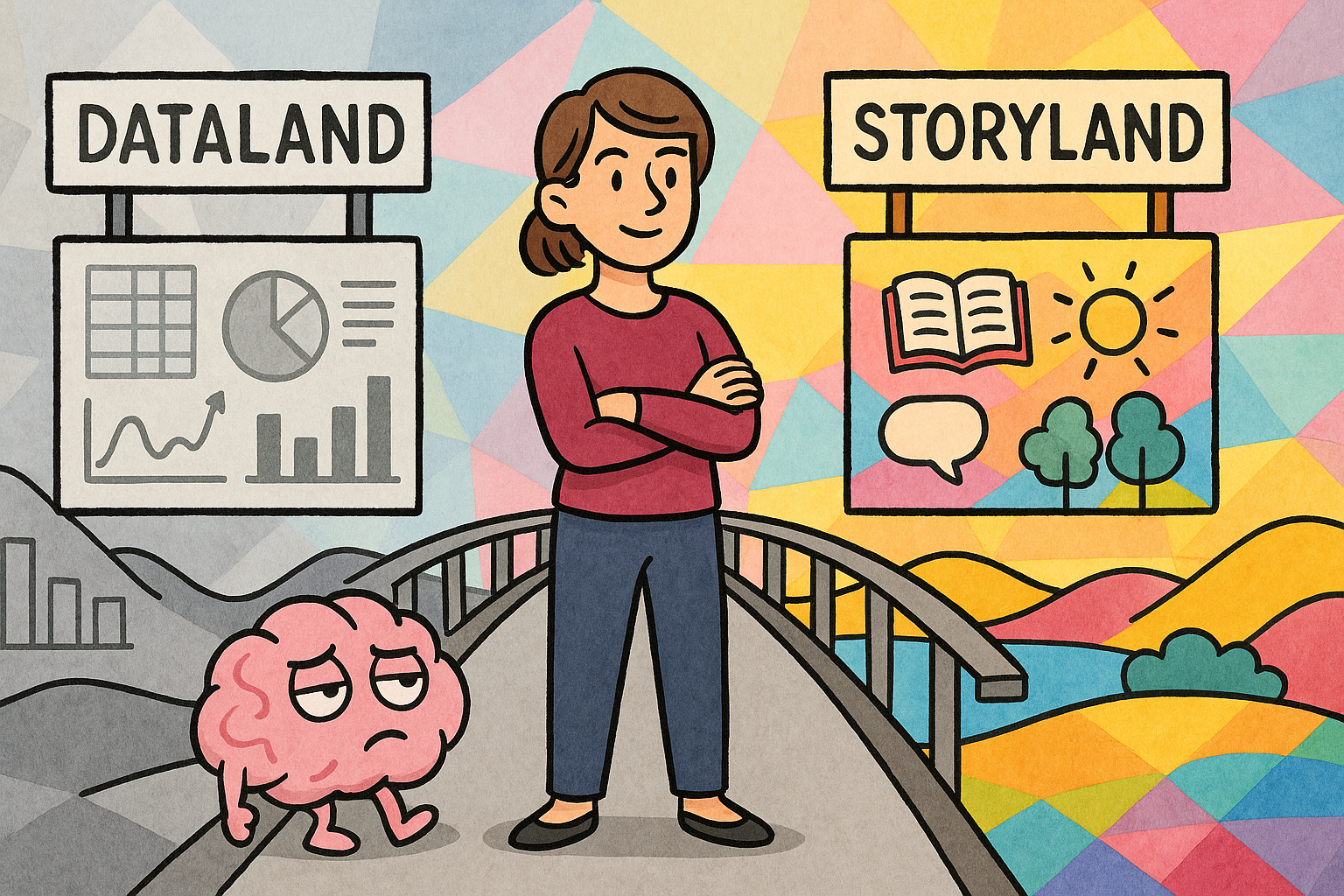Storytelling for Data-Driven Professionals: How to Make Your Business Presentations More Engaging and Persuasive
- Studies show storytelling improves memory, reduces resistance, and drives action more effectively than data alone.
- It can also reduce mental clutter. It lowers the noise, organizes complexity, and helps the brain focus on what matters.
- Storytelling is tricky to use in actual business practice where data is the king. Many professionals avoid it because it feels unprofessional, inauthentic, or hard to apply when you’re presenting data, research, or strategy.
- I reverse-engineered some of the best storytelling frameworks and tools to find a set of guidelines that actually works in the real world.
- The 14 storytelling tactics that work in business are
- Structure and Strategy
- Start with the audience.
- Know what you want your audience to do.
- Have one Big Idea.
- Design an emotional journey, not just an agenda.
- Tactics
- Start with the end in mind.
- Open with a person, not a pie chart.
- A story doesn’t have to be about a person.
- Use micro-stories.
- Build a bigger narrative from your micro-stories.
- Use language that sparks emotion and clarity.
- Make your metrics meaningful.
- Pause.
- End with meaning, not just metrics.
- Cut in half (then cut again).
- Use AI to shape your story.
- Structure and Strategy

Introduction: Confessions of a Data Loyalist
If you know me at all, you know I'm a data, logic, and facts gal. Maybe it’s genetic. Maybe it’s the result of being raised by a professor. Either way, I’ve always believed that data is the best way to explain things and convince people. I mean, if a reliable study proves something, what better evidence is there?
And then there's storytelling.
We’ve all heard the hype: Want to pitch an idea? Storytelling. Present data? Storytelling. Teach people something? You guessed it, storytelling.
I was never truly sold on the idea. Why not?
- Professional norms: In the business industry, we speak in KPIs and graphs, not scenes and characters. Using stories feels unprofessional, even unacceptable in some contexts.
- Statistical rigor: Stories focus on one person. It’s so easy for them to be dismissed by skeptics as anecdotal evidence.
- Authenticity concerns: Often, there just isn’t a story. Making one up — a fictional client or employee — feels dishonest. Given the choice, I’d pick real data every time.
In short: Storytelling? Charming, but a little fluffy. Not serious enough for the type of business we do here. It’s like there are two worlds: Dataland and Storyland. Those living in Storyland insist we speak their language but that’s just not how things work in Dataland.
And then, a few weeks ago, my colleague Emma asked me to help prep a client workshop. I casually suggested using storytelling, just to realize that it's not such an easy endeavour. She loved the idea and wouldn’t let me back out. Thank God, because that forced me to revisit everything I’d learned from IDEO U about storytelling, and finally build a bridge between Dataland and Storyland.
In this article, I want to share what I learned, how I made storytelling practical, and most importantly, why and how to use storytelling in business — even when you live in Dataland.
Part 1: Does storytelling actually work?
Before we cross over to Storyland, though, let’s do exactly what any rational, data-drien professional would do: let's look at the data. Does storytelling genuinely influence behavior, or is it just hype? Turns out, the evidence is clear:
1. Stories drive action more than stats.
2. Stories lower skepticism.
3. Stories are stickier than facts.
4. Stories persuade through simplicity and emotion.
5. The best approach? Combine story and data.
So yes, storytelling works. And ironically, if you believe in evidence… well, the evidence points to storytelling.
Now the real question: How do we do it in practice, without sounding like TED Talk wannabes in a room full of charts?
Part 2: How to practically use storytelling in data-driven business.
We’ve all been there. You want to try something new, but your deck is 47 slides long. Half the team thinks “storytelling” means fluff. And the slides are already locked.So let’s make it simple. Here’s a practical guide for blending story into a business presentation, even if your world runs on numbers.
Structure and Strategy
1. Start with the audience.
💡 Ask yourself: Who’s in the room? What do they care about (emotionally, practically, politically)? What’s at stake for them?
It’s hard to take people on a journey if you don’t know who they are. Clarity on your target audience will help you shape your storyline and decide which content to keep (e.g., data), and what to leave out.
2. Know what you want your audience to do.
3. Have one Big Idea.
💡 Ask yourself: What’s the one thing I want them to take away?
4. Design an emotional journey, not just an agenda.
But, honestly, for most business presentations, these frameworks can feel overly complex or restrictive. So let’s simplify: Instead of following a complicated arc, map the emotions you want your audience to feel.
This was one of the most eye-opening lessons I took from IDEO U: to stop structuring presentations as “blocks of content” and start structuring them as “blocks of emotions.”
💡 Ask yourself: What do I want my audience to feel, and when?
For example, let’s say I’m presenting to an HR audience about employee burnout. My goal is to propose a new psychological resilience training program based on a healthier definition of true resilience. Here’s how I’d structure that emotional journey:
- First, I’d show data to make them concerned: Employee burnout is even worse than we thought. We’ve invested in wellbeing tools, but the numbers aren’t improving.
- Then I’d move them from shocked to an “aha” moment, reframing the issue: We’ve been helping people cope, not heal. Our definition of resilience is broken.
- Finally, I’d shift them to feeling empowered and ready to act: There’s a better way to build resilience. Here’s a practical training program that actually helps employees recover and thrive.
Knowing the emotional path makes it easier to decide what data and insights to include, and what to leave out.
Tactics
I hope these Structure and Strategy tips feel practical and doable for most business presentations. But let’s be honest: You won’t always have full control over content or structure. Some decks are pre-written, others cover several unrelated topics, and not every meeting calls for big emotional shifts. Even in those cases, you can still use storytelling tools to make what you present more engaging and persuasive.As I was navigating this myself, I put my strategic brain to work. I combed through the frameworks, templates, and storytelling advice, and reverse-engineered what actually works in practice. What came out is the list I wish I had when I first tried to bring story into a slide deck. It’s clear, practical, and designed for real-world business settings — especially when data, strategy, and research are your starting point.
You don’t need to use them all. Start small. Try one. Build from there.
10 Practical Storytelling Tactics That Will Make Your Business And Data Presentations Land
1. Start with the end in mind.
Before opening PowerPoint, identify your one Big Idea — the single message you want remembered. Filter every slide and stat through that lens. If it doesn’t support your main point, cut it. They won’t remember it next week anyway.
2. Open with a person, not a pie chart.
Open your presentation with a human moment: a specific challenge, a quote, or a question from the field. Even a single line —“Let me tell you what happened last Tuesday…” — can draw your audience in.Stories stick when they’re vivid and sensory, grounded in real scenes your audience can easily imagine. For example: “Imagine you’re a new manager walking into your first budget meeting…” The more clearly people picture your story, the more deeply they’ll feel and remember your message.
3. A story doesn’t have to be about a person.
One of the biggest roadblocks I personally face and hear from others: “But I don’t have a real person story to talk about.”Good news: stories don’t need a hero in a cape. They just need change. That could be a broken process, a shift in data, or a flawed assumption. If something moved, failed, improved, or flipped — that’s a story.
Here are three ways to tell a story without a human protagonist:
- A broken process inside the company: tell a story about a clear moment of breakdown, and how you fixed it.
💭 Storytelling example: Our onboarding process looked fine on paper. But when we tracked engagement, week 3 was a black hole — a 40% drop. That told us new hires were getting lost. We restructured manager check-ins at that point. Six months later, we saw a 20% boost in retention.
- A product’s journey: tell a story of how something evolved — a campaign, a product, a feature.
💭 Storytelling example: We launched Campaign A as a pilot in one market. It was designed for a niche audience but it doubled our usual engagement. That result made us reconsider its potential. We scaled it across three regions, and conversions climbed 12% overall.
- A surprising data shift, where the numbers themselves are the main character.
If there’s change, you have a story. So don’t just look for people, look for change. That’s where your story lives.
4. Use micro-stories.
I used to think a good business presentation needed one perfectly crafted story — like in storytelling courses, with a main character, dramatic arc, and emotional climax. But most business presentations don’t work that way. We’re dealing with data, research, and strategy. Slides are pre-set. Topics shift. Time is tight.The solution? Think smaller. A micro-story is a short, specific moment of change — a surprising data point, a flawed assumption, a decision that paid off. One situation. One quote. One challenge overcome. You don’t always need a big story. You need one moment that brings the key insight to life, and supports your Big Idea.
5. Build a bigger narrative from your micro-stories.
Here’s the next move. If you’ve got a few strong micro-stories, step back and ask: Do they connect? If each story supports the same Big Idea, you already have the building blocks of a bigger narrative.Let me give you an example.
Last month, I was prepping for a workshop with a pharma client — five behavioral barriers to diagnosis and treatment. Important stuff, but I knew the risk: data overload. Five sections. Dozens of insights. No clear throughline. It felt like death by detail.
I kept circling the content, trying to find something to pull it together. At first, nothing clicked. They were just five separate barriers. Until I saw it: one of the five wasn’t just another barrier — it was the root cause. That changed everything.
I added a single slide upfront with the core insight in one sentence. Then, as I walked through the data, I kept looping back to it — anchoring each point in that bigger idea. I knew that even if I lost someone along the way, they’d remember that sentence. It gave the whole presentation a backbone. A story to hold onto.
How to find the thread?
💡 Ask yourself…
- Is there a cause-and-effect relationship between mini-stories?
- Do they follow a natural sequence (e.g. steps, journey, timeline)?
- Do they stem from the same root issue or point to one key insight?
- Can one metaphor capture the pattern?
6. Use language that sparks emotion and improves clarity.
Sometimes storytelling is nothing but a few small shifts in how we talk about the data, without even needing to change what we say.- Add contrast and tension. Use words like “but,” “until,” “even though” to signal change. Without tension, your story has no pulse. For example,“We expected a 12% lift… but the results were flat. Until we looked closer.”
- Talk in present tense. It makes your story feel immediate and alive. “She walks into the meeting and realizes the report is wrong.” hits harder than “She walked…”
- Invite curiosity. Open with: “Here’s what surprised us…” or “Let me show you what happened.” It pulls people in.
- Explain a shift, don’t just talk numbers. Most presentations dump numbers, while stories explain a change. Don’t just show numbers. Tell your audience what changed. For example,“Revenue jumped by $700K — and here’s what drove it.”
- Turn metrics into consequences. Make abstract numbers real. Tie them to what they mean for people, resources, or decisions.“That 8% lift in retention? It means 11 more people stayed — including two key managers.”
- Cut the jargon. Say: “They felt overwhelmed and didn’t know who to ask,” not “users experienced decision-making friction.”
7. Pause.
Don’t just talk at your audience. Let them think with you. A well-placed pause can turn a data dump into a shared moment of insight. Ask open questions like:- “What would you do next?”
- “Have you seen this happen before?”
This invites reflection and creates ownership, not just understanding.
8. End with meaning, not just metrics.
End with a takeaway that ties it all together. Use lines like:- “Here’s what this means for next quarter…”
- “The bigger story these numbers tell is…”
- “Why this matters beyond the spreadsheet…”
Don’t wrap with “That’s the data.” Always tie your final point back to your Big Idea. For example: “All of this points to one thing: if we want to retain talent, we need to fix week-two onboarding. That’s where the drop-off starts.”
9. Cut in half (then cut again).
When you’re close to the work, every detail feels important. But to your audience, too much data is just noise. Here’s the rule: If it doesn’t support your Big Idea or move your audience emotionally, it doesn’t belong.
💡 Always ask: Will this help them understand, feel, or remember the point I’m trying to make?
If not, cut it. Less content = more clarity.
10. Use AI to shape your story.
Feeling stuck, still confused or overwhelmed by all the tips? First of all, please remember you don’t have to use them all. Just pick one or two that fit your context and build from there.And remember: you don’t have to do this alone. Use tools like ChatGPT to help turn dry content into something more compelling.
Here’s a prompt to get you started. Copy, paste, and customize:
I’m creating a business presentation. The topic is: [insert your topic].
My Big Idea is: [insert one key message or takeaway].
I want to include a simple story that makes this point memorable.
The audience is: [describe your audience, e.g. senior leaders, HR managers, marketing team].
The tone should be professional but human.
Help me write a short story that includes:
- A relatable moment or problem.
- Some tension or surprise.
- A resolution that reinforces my Big Idea.
Part 3: Your biggest barrier isn’t your audience. It’s you.
By now, we know that storytelling works. It makes presentations more emotionally engaging, more memorable, and more persuasive. You’ve seen how to use it, whether you go all in or just add a few small shifts to a data-first deck.But if you’re anything like me, when you sit down to work on your next presentation, you’ll hear that inner voice:
And here’s what I’ll say: If you want people to remember what you said — and act on it — you need story. But no, you don’t have to choose between story and data. The research is clear: story + data is more persuasive than either alone. Data gives evidence. Story gives it meaning.
Still feel stuck? Try this:
1. Think “Story + Data,” not “Story vs. Data.”
2. Know what it is that you actually want.
3. Start small. Really small.
That’s why I built the approach in this article. To make it practical and doable. You don’t have to master narrative arcs or rewrite every slide. You don’t need a perfect arc or dramatic climax. Just add:
- One quote that reveals a tension.
- One shift that challenges an assumption.
- One moment that sticks with your audience.
And when it works, you’ll gain confidence to keep building more complex narratives. The goal isn’t to be a storytelling genius. It’s to be a more effective communicator.
A Final Thought
As I was building this list, something clicked. At first, I thought I was collecting storytelling tactics to help a few friends and colleagues feel less awkward about using story in everyday work. But halfway through, I realized something bigger: storytelling doesn’t just make things more engaging. It also reduces information overload, cuts through the boredom of endless meetings, and helps our work move forward more efficiently.
If we can present in a way that helps people understand what we’re saying, remember what matters, and know what to do with it, we’ve already done something powerful. We’ve removed unnecessary complexity without frying anyone’s brain. And good storytelling does exactly that. It lowers the noise, organizes the chaos and gives the brain fewer things to track.
In behavioral science terms, that’s called reducing cognitive overload. In real life, it’s called clarity. And honestly? We could all use a little more of that right now.





